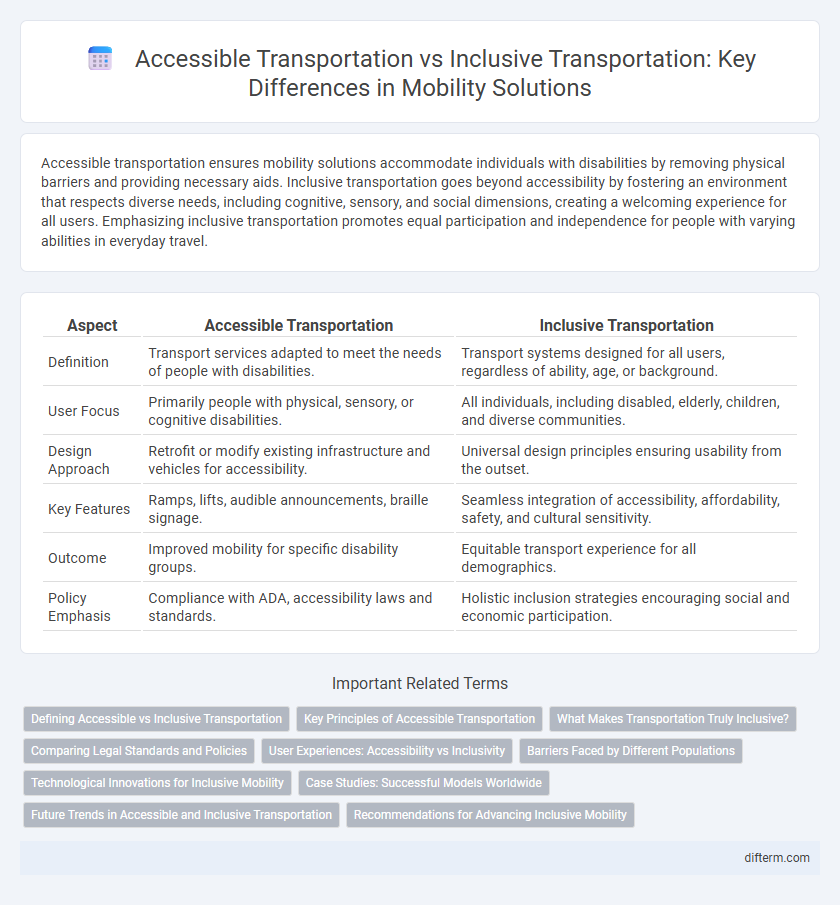Accessible transportation ensures mobility solutions accommodate individuals with disabilities by removing physical barriers and providing necessary aids. Inclusive transportation goes beyond accessibility by fostering an environment that respects diverse needs, including cognitive, sensory, and social dimensions, creating a welcoming experience for all users. Emphasizing inclusive transportation promotes equal participation and independence for people with varying abilities in everyday travel.
Table of Comparison
| Aspect | Accessible Transportation | Inclusive Transportation |
|---|---|---|
| Definition | Transport services adapted to meet the needs of people with disabilities. | Transport systems designed for all users, regardless of ability, age, or background. |
| User Focus | Primarily people with physical, sensory, or cognitive disabilities. | All individuals, including disabled, elderly, children, and diverse communities. |
| Design Approach | Retrofit or modify existing infrastructure and vehicles for accessibility. | Universal design principles ensuring usability from the outset. |
| Key Features | Ramps, lifts, audible announcements, braille signage. | Seamless integration of accessibility, affordability, safety, and cultural sensitivity. |
| Outcome | Improved mobility for specific disability groups. | Equitable transport experience for all demographics. |
| Policy Emphasis | Compliance with ADA, accessibility laws and standards. | Holistic inclusion strategies encouraging social and economic participation. |
Defining Accessible vs Inclusive Transportation
Accessible transportation ensures that vehicles and infrastructure meet basic standards to accommodate individuals with disabilities, such as wheelchair ramps and priority seating. Inclusive transportation goes beyond accessibility by integrating diverse user needs, cultural considerations, and promoting equitable access for all demographics, including elderly, low-income, and marginalized communities. This holistic approach fosters social inclusion and equal participation in mobility systems.
Key Principles of Accessible Transportation
Accessible transportation ensures barrier-free access for individuals with disabilities by prioritizing features like ramps, tactile guides, and audible signals. It emphasizes compliance with legal standards such as the Americans with Disabilities Act (ADA) to guarantee equal mobility opportunities. Key principles include safety, affordability, and adaptability to various disability needs, fostering independent travel for all users.
What Makes Transportation Truly Inclusive?
Transportation becomes truly inclusive when it addresses the diverse needs of all users, including individuals with disabilities, older adults, and marginalized communities, by providing adaptable infrastructure and services. Accessible transportation ensures physical access, such as ramps and low-floor vehicles, while inclusive transportation expands beyond physical design to offer ease of use, affordability, safety, and reliable information for every passenger. Key features like real-time communication, community engagement, and policy commitment to equity underpin the transformation from mere accessibility to comprehensive inclusivity in mobility systems.
Comparing Legal Standards and Policies
Accessible transportation ensures basic compliance with legal standards such as the Americans with Disabilities Act (ADA), mandating features like wheelchair ramps and audible signals on public transit. Inclusive transportation extends beyond compliance by integrating universal design principles and policies that accommodate diverse user needs, including cognitive disabilities and sensory impairments. Comparing these frameworks reveals a shift from minimum legal requirements to proactive policies promoting equitable mobility for all individuals.
User Experiences: Accessibility vs Inclusivity
Accessible transportation ensures basic access for users with disabilities by providing features like ramps, elevators, and audio announcements, focusing on compliance with legal standards. Inclusive transportation goes beyond accessibility by designing services that accommodate a broad range of user needs, including cognitive, sensory, and cultural diversity, enhancing overall user satisfaction. Prioritizing inclusivity improves user experiences by promoting autonomy, comfort, and equal participation for all passengers, fostering a more equitable mobility landscape.
Barriers Faced by Different Populations
Accessible transportation addresses physical and sensory barriers by providing ramps, auditory signals, and adjustable seating, primarily benefiting individuals with disabilities. Inclusive transportation expands beyond physical access to consider cultural, linguistic, and socioeconomic factors affecting diverse populations, such as language barriers and affordability. Various groups face unique challenges, including elderly individuals who require assistance with navigation and low-income communities lacking reliable transit options.
Technological Innovations for Inclusive Mobility
Technological innovations for inclusive mobility prioritize adaptive features such as AI-powered navigation systems, voice-controlled interfaces, and real-time accessibility alerts, enabling seamless travel for individuals with diverse disabilities. Autonomous vehicles equipped with advanced sensor technologies and customizable seating arrangements enhance accessibility by addressing mobility challenges in public and private transit. Integration of smart infrastructure with Internet of Things (IoT) devices facilitates dynamic route adjustments and personalized assistance, promoting equitable transportation options for all users.
Case Studies: Successful Models Worldwide
Case studies from cities like Curitiba, Brazil, and Helsinki, Finland, demonstrate successful models of accessible transportation that prioritize barrier-free design and affordable transit options for individuals with disabilities. Inclusive transportation frameworks in Singapore and Stockholm integrate digital tools and community engagement strategies to accommodate diverse mobility needs, fostering societal participation. Evidence from these global examples underscores the effectiveness of combining infrastructure improvements with policy innovations to create transportation systems that serve all users equitably.
Future Trends in Accessible and Inclusive Transportation
Future trends in accessible and inclusive transportation emphasize the integration of advanced assistive technologies such as AI-powered navigation systems and adaptive vehicle designs to enhance mobility for individuals with disabilities. Investments in smart infrastructure, including tactile pavements and audio-visual signaling, aim to create seamless travel experiences that accommodate diverse needs. Emphasizing policy frameworks that mandate accessibility standards ensures transportation networks evolve toward comprehensive inclusivity worldwide.
Recommendations for Advancing Inclusive Mobility
Accessible transportation ensures basic usability for people with disabilities, while inclusive transportation integrates diverse needs across age, ability, and socioeconomic status to promote equity. Recommendations for advancing inclusive mobility emphasize universal design principles, expanded service options such as demand-responsive transit, and leveraging technology for real-time accessibility information. Partnerships among government agencies, community organizations, and private providers play a crucial role in fostering transportation systems that accommodate all users seamlessly.
accessible transportation vs inclusive transportation Infographic

 difterm.com
difterm.com